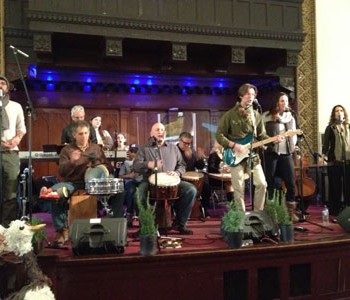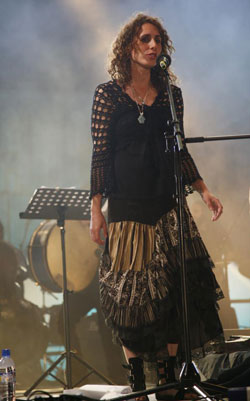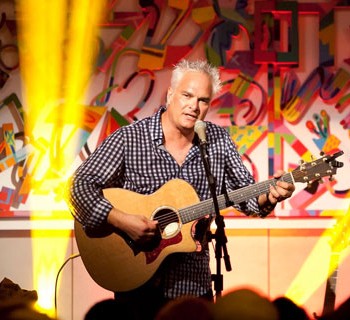Arts
Feature
In Shul, a Different Drum

At hip West Los Angeles congregation Ikar, Friday night services might start with a drum-infused, Mizrahic Yedid Nefesh, followed by a familiar Carlebach melody marked by ecstatic foot stomping.
The melody then leads into a hypnotic chant composed by Hillel Tigay, Ikar’s hazzan and music director, and finally a Sefardic “L’kha Dodi” from Jerusalem that switches midway to a Camp Ramah standard. A “davening team,” usually made up of two percussionists with hand drums and two singers who harmonize and improvise, accompanies Tigay in the Westsid
e JCC auditorium that Ikar has called home for eight years. Once a month, Ikar meets in a smaller room where congregants stand together, promoting closeness.
Ikar’s website advertises its services as “traditional and experimental, contemplative and ecstatic…a fusion of spirit and purpose, old and new, East and West…. Music is the crowbar that pries open the heart, awakening us and reminding us what’s possible in our lives and in the world.”
“The element of surprise is part of what we do,” says Tigay, 44, who selects the melodies and pace of the davening based on the mood of the room. “Is it a joyous simha? Or did someone just die?”
The approach at Ikar and at other congregations across the country is intended to enrich Jewish worship for a new generation. From fabled B’nai Jeshurun in New York to the Jewish renewal hubs of the San Francisco

Bay area, congregations are reaching past the fixed canon of Ashkenazic nusah (prayer chant) to a different type of musical leadership: music directors who are transferring their styles and skills from the stage to the synagogue and are recharging and building community by plugging into the transformative power of music.
The musicians have arrived at the synagogue’s door from diverse religious paths, having explored a host of musical genres along the way. Many have studied the cantorial tradition even if they are not ordained cantors. Their task, as Tigay puts it, is to create “a profound prayer experience that moves congregants and guides them to feel attuned to our traditions and texts.” To do so, they are suffusing what they perceive as an old-time, black-and-white musical palette with rhythmic color and spiritual depth. Almost nothing is off-limits—Sufi to Simon & Garfunkel.
“We have to put new oxygen into the flame so it fans, grows and spreads,” Tigay declares.
Joey Weisenberg, 32, music director at Brooklyn’s Kane Street Synagogue and founder and creative director of the new Hadar Center for Communal Jewish Music in New York, encourages people to find their voice in Jewish music by singing together unaided by instruments. He reaches both to musical modes like klezmer, niggunim (wordless melodies) and nusah and to contemporary expressions like jazz, blues, flamenco and soul.
A mandolinist, guitarist, singer and percussionist who has performed and recorded with dozens of bands, Weisenberg became bored with traditional performance styles and realized there was a parallel in American synagogues. “Big shuls served a big purpose: to show we were strong and powerful,” he says. “My generation is spoiled by that acceptance.”
In Building Singing Communities: A Practical Guide to Unlocking the Power of Music in Jewish Prayer, published by Mechon Hadar (an educational institution that grew out of an independent egalitarian minyan), Weisenberg suggests changing the archi

tecture of the davening space to maximize physical proximity. Instead of a high bima with a remote prayer leader, he clears away extraneous chairs and places the leader in the center. His purpose is not only to unify individuals, but also to foster a musical tikkun olam: “We literally need to reclaim people from the four corners of the shul. If we can model it in shul we can do it on a larger basis—the earth.” Being in tune with others on a micro level can lead to global harmony, he posits.
Weisenberg grew up in a conservative home in Milwaukee. In his teens, his grandfather took him to the Shabbat table of Hasidic Rabbi Michel Twerski, where niggunim and songs were interspersed with words of Torah. That profound experience of singing together is what Weisenberg hopes to transfer to an egalitarian setting. “I’m trying to work toward the ‘re-shtetlization’ of our collective mentality—to learn how to come closer together and reclaim the intimacy of our tradition.”
In contrast, the davening Basya Schechter remembers from her Hasidic Borough Park upbringing was not about connecting but about “getting through, mumbling and shuckling,” she says. “People went [to shul] because of obligation and what they served at Kiddush.” Yet, throughout her career as a performing and recording artist with her band, Pharaoh’s Daughter, which fuses Hasidic, Middle Eastern and ecstatic and devotional world music, she mourned the loss of a stable communal ritual. “I left that world…but I am constantly pulled back,” says Schechter, music director at Romemu, a New York congregation that integrates prayer with practices like yoga and meditation. “I decided to…go back to more of the things I come from—but to energize it,” she says. Schechter recently performed at New York’s Lincoln Center and is releasing her seventh album, Dumiya, based on prayers and piyyutim (liturgical poetry).
“We have to let go of a lot of sacred cows, especially musically,” says Tigay. “[The traditional melody for] Aleinu is not from Sinai. [It was composed by Austrian cantor Salomon Sulzer, 1804-1890.] What resonates now and seems accessible is what feels deeply authentic, associated with something ancient, biblical and organic.”
His own album, Judeo, beckons listeners to absorb what Tigay describes as “modern music from the past.” A reimagining of what worship might have sounded like in Temple times, it features biblical texts and instruments: trumpets, drums, Middle Eastern strings (qanoun), flutes (ney), shofar and more. “Music can be a spiritual offering of joy and was as prevalent as sacrifices,” says Tigay, adding that the repetitive beats of Middle Eastern music that hand drums enhance can transport participants to meditative states. “People in ancient times knew there was nothing like music to bring the presence of God into the mind.”
The son of a Bible scholar, Tigay grew up literate in Conservative liturgy, leading High Holiday services as a teenager. Music was always what moved him most, he says, but he was at times uninspired by the operatic-style synagogue nusah and could not envision merging the British and Irish pop music he loved with Judaism. He majored in musicology at the University of Pennsylvania and later cofounded the now-defunct Jewish rap band M.O.T. (Members of the Tribe).
Musicians like Tigay, Schechter and Weisenberg are not breaking the mold without precedent. In fact, mainstays like Shlomo Carlebach and Debbie Friedman were pioneers who reinvigorated and democratized Jewish music, using biblical and liturgical texts in singable settings. B’nai Jeshurun’s success added a fresh layer: the sound of world beats, especially from the vast range of Sefardic and Mizrahic liturgical music that has been largely unheard in American synagogues. “There was something broken in the role of the synagogue community or even in Jewish life, especially in the liberal community,” says Ari Priven, BJ’s hazzan and music director. “We came in at the right time to offer one alternative.”
Like two of BJ’s three rabbis, Priven, 51, was born in Buenos Aires and was trained by the late Rabbi Marshall Meyer, who founded Comunidad Bet El, a Conservative synagogue, and Seminario Rabinico Latinoamericano, a Conservative rabbinical school, both in Argentina. With his friend and student Rabbi Rolando Matalon, Meyer revitalized BJ after returning to the United States in the 1980s; they invited Priven to join in 1989. “Our community in Buenos Aires broke the walls of the traditional synagogue,” he says, broadening the Ashkenazic tradition to incorporate the repertoire of different communities.
At BJ, the clergy team reproduced that approach and introduced an instrumental ensemble (Schechter played darbuka, riq and frame drum there for 15 years); many Conservative synagogues do not allow instruments. They brought in folk and world music; Oriental piyyutim; meditational and spiritual music written by composers like Jewish Renewal Rabbi Shefa Gold; and Shabbat melodies by Israeli pop composers. “People have said that we are part of creating ‘minhag America,’ searching within traditional liturgical material as well as the work of new composers,” says Priven. How does the eclectic selection hang together? “We’re not doing the traditions in such a traditional way. We take them and make them our own.”
The rabbi’s partnership in the congregation’s musical direction is critical. Often the rabbi is a charismatic leader like Ikar’s Sharon Brous or Romemu’s David Ingber, who have founded their own congregations. Matalon, of Syrian descent, is a musician in his own right: He plays the oud, is a member of the New York Arabic Orchestra and founding codirector of Piyut North America. At the more mainstream Conservative Sinai Temple in Los Angeles, Rabbi David Wolpe initiated a bold move 16 years ago: He invited musician Craig Taubman to lead a short, folksy participatory young professionals’ service without the usual organ and chorus. Friday Night Live began with a guitar and an upright bass. The service, which is ending in June, has featured a diverse range of guest musicians and speakers from Elie Wiesel to Israeli performer David Broza, and has been replicated all over the country.
A profilic composer who has recorded many albums of Jewish music, Taubman, 55, attributes his early recognition that music is integral to prayer to his years at Camp Ramah; he was later inspired by Friedman and, even later, realized many of the melodies he sang were Carlebach’s. Taubman and his wife, Louise, recently purchased the 105-year-old first home of Sinai Temple, which he envisions as a multifaith house of worship and cultural center. The Pico Union Project, will house a freestanding synagogue—a space for performers, singers, composers, conductors and rabbis. Whatever melodies a hazzan or music director chooses, Taubman emphasizes, “at the end of the day it’s the relationship the prayer leader has with the congregation that’s important. People make the space holy.”
In fact, it is not just congregants who yearn for community but the artists themselves. “Some of us have lived lives that have been self-directed, self-generated and non-accountable,” says Schechter. “The Jewish community doesn’t support the arts in a real way. We cannot move to the next level spiritually, emotionally, creatively and financially. I’ve been for myself. I want to experience a more stable life.” She is now in the cantorial program through ALEPH: Alliance for Jewish Renewal.
Even at a more staid institution like the Jewish Theological Seminary, the approach is evolving. “We have changed how we are training people,” says Cantor Nancy Abramson, director of the H.L. Miller Cantorial School. “Students have to be prepared to represent the past through traditional [Ashkenazic] nusah and at the same time to be able to speak to contemporary Jews. We are now teaching students how to get in and out of the nusah so they can sing a Josh Nelson [Jewish gospel] or Carlebach melody and then move back.”
Abramson remembers that Friedman’s popularity once caused some cantors to fear “no one would want to hear anything else. We don’t have any reason to be afraid,” she says. “What we need to do is learn from one another. No service should be one-size-fits-all. People want to sing—and that’s a wonderful thing.”
“The main thing as a hazzan is to be a healer without any judgments,” says Richard Kaplan, hazzan at Temple Beth Abraham, www.tboakland.org, a Conservative synagogue in Oakland, California, and cofounder with Rabbi Michael Zeigler of Shir Hashirim a Friday night Renewal minyan that meets once a month in Berkeley. “My role as healer is to channel as much Divine love through prayer and music. The encoding of spirituality into sound is miraculous…. Human beings are just instruments for ruah hakodesh [the Divine spirit].”
Kaplan is a musicologist who specialized in baroque vocal technique and choral conducting; a lover of ethnomusicology, a jazz pianist and a student of Eastern philosophies. Raised in a multidenominational Los Angeles home, he rediscovered Judaism through Martin Buber and Jewish mysticism, then apprenticed for three years with a Conservative cantor. He was ordained by ALEPH and, intrigued by Mizrahic music, researched it extensively. His three albums of sacred Jewish music emphasize Mizrahic, Hasidic and Jewish mystical traditions.
The two services Kaplan leads span the range of possibility. At Shir Hashirim, oud, qanoun, dumbek, ney, violin, poetry, meditation, dance and science contribute to the “worldcentric minyan.” At the Shabbat morning Conservative synagogue, there’s not even a hand drum.
Within this vast spectrum, it’s up to congregations and communities to determine how prayer will speak to the next generation. What’s clear for the musicians at the helm is that spirit and music reinforce one another.
“Music enriches Torah and Torah enriches music,” says Weisenberg.
“Our challenge is to make the old new and the new holy,” says Taubman, paraphrasing celebrated 20th-century Rabbi Abraham Isaac Kook. “It’s not automatic. What makes it holy is if it sticks.”








 Facebook
Facebook Instagram
Instagram Twitter
Twitter
jerry weiner says
Sholom:
I would love to know what prayer book you use for Friday shabbat and where I could obtain one.
I recently have been using A SIDDUR FOR EREV SHABAT which I bought from Rabbi Marcia Prager in Philadelphia. Have you heard of her and her Siddur?
The prayer book we use at at the Temple in Des Moines is a bit antiquated for my taste. However, this coming Friday will be the debut of a new Siddur which I have not seen–MISHKAN TEFILAH. Have you heard of it?
Thank you.
Jerry Weiner